Lazinica A. (ed.) Particle Swarm Optimization
Подождите немного. Документ загружается.


Using Opposition-based Learning with Particle Swarm Optimization
and Barebones Differential Evolution
381
opposition-based learning improved the performance of both PSO and BBDE without
requiring any extra parameter.
PSO iPSO
Sphere 0(0) 0(0)
Rosenbrock
22.191441
(1.741527)
20.645323
(0.426212)
Rotated hyper-
ellipsoid
2.021006
(1.675313)
0.355572
(0.890755)
Rastrigin
48.487584
(14.599249)
27.460845
(11.966896)
Ackley
1.096863
(0.953266)
0(0)
Griewank
0.015806
(0.022757)
0.006163
(0.009966)
Salomon
0.446540
(0.122428)
0.113207
(0.034575)
Table 1. Mean and standard deviation (±SD) of the function optimization results
BBDE iBBDE
Sphere 0(0) 0(0)
Rosenbrock
25.826400
(0.216660)
25.942146
(0.209437)
Rotated hyper-
ellipsoid
15.409460
(20.873456)
0.905987
(1.199178)
Rastrigin
34.761833
(28.598884)
0(0)
Ackley 0(0) 0(0)
Griewank
0.000329
(0.001800)
0(0)
Salomon
0.166540
(0.047946)
0.149917
(0.050826)
Table 2. Mean and standard deviation (±SD) of the function optimization results
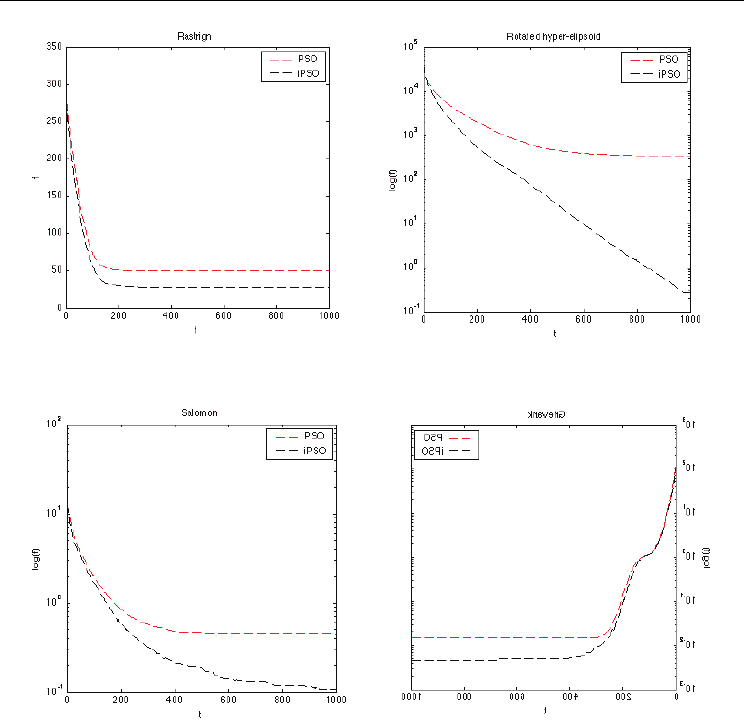
Particle Swarm Optimization
382
Figure 1. Performance Comparison of PSO and iPSO when applied to selected functions
7. Conclusion
Opposition-based learning was used in this chapter to improve the performance of PSO and
BBDE. Two opposition-based variants were proposed (namely, iPSO and iBBDE). The iPSO
and iBBDE algorithms replace the least-fit particle with its anti-particle. The results show
that, in general, iPSO and iBBDE outperformed PSO and BBDE, respectively. In addition,
the results show that using OBL enhances the performance of PSO and BBDE without
requiring additional parameters. The ideas introduced in this chapter could also be used
with any PSO/BBDE variant.
Future research will investigate the effect of noise on the performance of the proposed
approaches. Furthermore, a scalability study will be conducted. Finally, applying the
proposed approaches to real-world problem will be investigated.
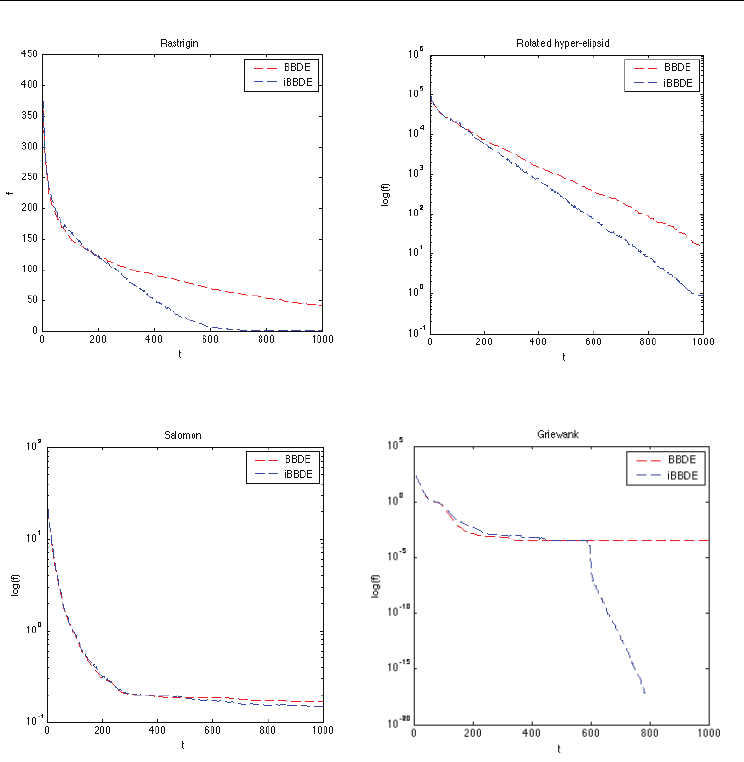
Using Opposition-based Learning with Particle Swarm Optimization
and Barebones Differential Evolution
383
Figure 2. Performance Comparison of BBDE and iBBDE when applied to selected functions
8. References
Clerc, M. & Kennedy, J. (2002). The Particle Swarm-Explosion, Stability, and Convergence in
a Multidimensional Complex Space. IEEE Transactions on Evolutionary Computation,
Vol. 6, No. 1, pp. 58-73.
Engelbrecht, A. (2005). Fundamentals of Computational Swarm Intelligence, Wiley & Sons.
Han, L. & He, X. (2007). A novel Opposition-based Particle Swarm Optimization for Noisy
Problems. Proceedings of the Third International Conference on Natural Computation,
IEEE Press, Vol. 3, pp.
624 – 629.

Particle Swarm Optimization
384
Kennedy, J. (1999). Small Worlds and Mega-Minds: Effects of Neighborhood Topology on
Particle Swarm Performance. Proceedings of the IEEE Congress on Evolutionary
Computation, Vol. 3, pp. 1931-1938.
Kennedy, J. (2003). Bare Bones Particle Swarms. Proceedings of the IEEE Swarm Intelligence
Symposium, pp. 80-87.
Kennedy, J. & Eberhart, R. (1995). Particle Swarm Optimization. Proceedings of the IEEE
International Joint Conference on Neural Networks, pp. 1942-1948.
Kennedy, J. & Mendes, R. (2002). Population Structure and Particle Performance. Proceedings
of the IEEE Congress on Evolutionary Computation, pp. 1671-1676, IEEE Press.
Omran, M., Engelbrecht, A. & Salman, A. (2007). Differential evolution based on particle
swarm optimization. Proceedings of the IEEE Swarm Intelligence Symposium, pp. 112-
119.
Price, K.; Storn, R. & Lampinen, J. (2005). Differential Evolution: A Practical Approach to Global
Optimization, Springer.
Rahnamayan, S.; Tizhoosh, H. & Salama, M. (2008). Opposite-based Differential Evolution.
IEEE Trans. On Evolutionary Computation, Vol. 12, No. 1, pp. 107-125.
Shi, Y. & Eberhart, R. (1998). A Modified Particle Swarm Optimizer. Proceedings of the IEEE
Congress on Evolutionary Computation, pp. 69-73.
Storn, R. & Price, K. (1995). Differential evolution - A Simple and efficient adaptive scheme
for global optimization over continuous spaces. Technical Report TR-95-012,
International Computer Science Institute.
Tizhoosh, H. (2005). Opposition-based Learning: A New Scheme for Machine Intelligence.
Proceedings Int. Conf. Comput. Intell. Modeling Control and Autom, Vol. I, pp. 695-701.
van den Bergh, F. (2002). An Analysis of Particle Swarm Optimizers. PhD thesis, Department
of Computer Science, University of Pretoria, Pretoria, South Africa, 2002.
van den Bergh, F. & Engelbrecht, A. (2006). A Study of Particle Swarm Optimization Particle
Trajectories. Information Sciences, Vol. 176, No. 8, pp. 937-971.
Wang, H.; Liu, Y.; Zeng, S.; Li, H. & Li, C. (2007). Opposition-based Particle Swarm
Algorithm with Cauchy Mutation. Proceedings of the IEEE Congress on Evolutionary
Computation, pp. 4750-4756.
24
Particle Swarm Optimization: Dynamical
Analysis through Fractional Calculus
E. J. Solteiro Pires
1
, J. A. Tenreiro Machado
2
and P. B. de Moura Oliveira
1
1
Universidade de Trás-os-Montes e Alto Douro,
2
Instituto Superior de Engenharia do Porto
Portugal
1. Introduction
This chapter considers the particle swarm optimization algorithm as a system, whose
dynamics is studied from the point of view of fractional calculus. In this study some initial
swarm particles are randomly changed, for the system stimulation, and its response is
compared with a non-perturbed reference response. The perturbation effect in the PSO
evolution is observed in the perspective of the fitness time behaviour of the best particle.
The dynamics is represented through the median of a sample of experiments, while
adopting the Fourier analysis for describing the phenomena. The influence upon the global
dynamics is also analyzed. Two main issues are reported: the PSO dynamics when the
system is subjected to random perturbations, and its modelling with fractional order
transfer functions.
2. Particle Swarm Optimization Basics
Evolutionary algorithms have been successfully applied to solve complex optimization
engineering problems. Together with genetic algorithms, the particle swarm optimization
(PSO) algorithm, proposed by (Kennedy & Eberhart, 1995), has achieved considerable
success in solving optimization problems. While PSO algorithms and related variants have
been extensively studied (Clerk & Kennedy, 2002), the influence of perturbations signals
over the operation conditions is not yet well known.
The PSO algorithm was proposed originally by Kennedy and Eberhart (1995). This
optimization technique is inspired in the way swarms behave and its elements move in a
synchronized way, both as a defensive tactic and for searching food. An analogy is
established between a particle and a swarm element. The particle movement is characterized
by two vectors, representing its current position x and velocity v. Since 1995, many
techniques were proposed to refine and/or complement the original canonical PSO
algorithm, namely regarding it’s tuning parameters (Shi and Eberhat, 1999) and by
considering hybridization with other evolutionary techniques (Lovbjerg et al., 2001).
In this study a standard elementary PSO algorithm is considered (see Fig. 1). The basic
algorithm begins by initializing the swarm randomly in the search space. As it can be seen in
Fig. 1, where t and t + 1 represent two consecutive iterations, the position x of each particle
is changed during the iterations by adding a new velocity v. This velocity is evaluated by

Particle Swarm Optimization
386
summing an increment to the previous velocity value. The increment is a function of two
components representing the cognitive and the social knowledge.
The cognitive knowledge of each particle is included by evaluating the difference between
the current position x and its best position so far b. The social knowledge of each particle is
incorporated through the difference between its current position x and the best swarm
global position achieved so far g. The cognitive and social knowledge factors are multiplied
by randomly uniformly generated terms ϕ
1
and ϕ
2
, respectively. The particles velocity is
restricted, in order to keep velocities from exploding, through the inertia term I (Clerk and
Kennedy, 2002).
Initialize Swarm
forAll particles
calculate fitness f
endfor
Repeat
forAll particles
v
t+1
=Iv
t
+ϕ
1
(b-x
t
)+ ϕ
2
(g-x
t
)
x
t+1
=x
t
+v
t+1
endfor
forAll particles
calculate fitness f
endfor
until Stopping criteria
Figure 1. Particle swarm optimization algorithm
3. Fractional Calculus
Fractional Calculus (FC) goes back to the beginning of the theory of differential calculus.
Nevertheless, the application of FC just emerged in the last two decades, due to the progress
in the area of chaos that revealed subtle relationships with the FC concepts. In the field of
dynamical systems theory some work has been carried out but the proposed models and
algorithms are still in a preliminary stage of establishment.
The fundamentals aspects of FC theory are addressed in (Gement, 1938; Méhauté, 1991;
Oustaloup, 1991; Podlubny, 1999). Concerning FC applications research efforts can be
mentioned in the area of viscoelasticity, chaos, fractals, biology, electronics, signal
processing, diffusion, wave propagation, percolation, modelling, control and irreversibility
(Ross, 1974; Tenreiro Machado, 2001; Torvik, 1984; Vinagre, 2002; Westerlund, 2002).
The FC is a generalization of the classical differential calculus to a non-integer order α ∈ C.
Since its foundation has been the subject of distinct approaches. Due to this reason there are
several alternative definitions of fractional derivatives. For example, the Laplace definition
of a derivative of order α ∈ C of the signal x(t), D
α
[x(t)], is a ‘direct’ generalization of the
classic integer-order scheme yielding equation (1):
[]
)(})({ sXstxDL
αα
=
(1)
for zero initial conditions, where s represents the Laplace operator. This means that
frequency-based analysis methods have a straightforward adaptation.
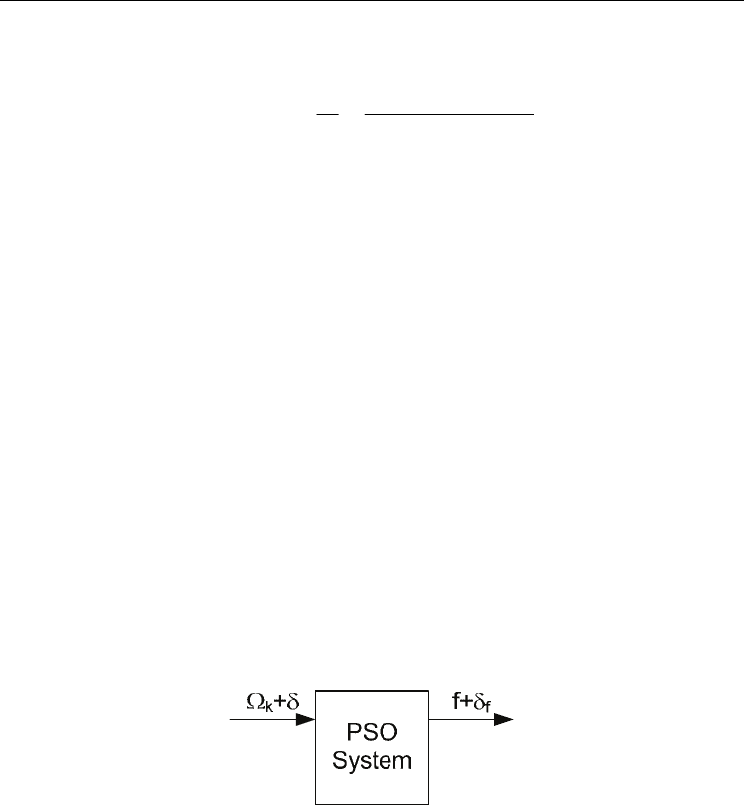
Particle Swarm Optimization: Dynamical Analysis through Fractional Calculus
387
An alternative approach, based on the concept of fractional differential, is the Grünwald-
Letnikov definition given by equation (2) where h represents the time increment.
[]
⎥
⎦
⎤
⎢
⎣
⎡
+−+Γ
−+Γ−
=
∑
+∞
=
→
0
0
)1)(1(
)()1()1(1
lim)(
k
k
h
kk
khtx
h
txD
α
α
α
α
(2)
An important property revealed by equation (2) is that while an integer-order derivative
implies just a finite series, the fractional-order derivative requires an infinite number of
terms. This means that integer derivatives are ‘local’ operators in opposition with fractional
derivatives which have, implicitly, a ‘memory’ of all past events.
The characteristics revealed by fractional-order models make this mathematical tool well
suited to describe phenomena such as irreversibility and chaos, because of its inherent
memory property. In this line of thought, the propagation of perturbations and the
appearance of long-term dynamic phenomena in a population of individuals subjected to an
evolutionary process seems to be a case where FC tools fit adequately, as shown in (Solteiro
Pires et al.; 2003, Solteiro Pires et al., 2006) for genetic algorithms.
4. PSO Swarm Optimization Dynamic analysis
4.1 Problem statement
This section introduces the problem formulation adopted in the study of the PSO dynamic
systems. Moreover, the dynamical phenomena involved in the signal propagation within
the PSO population is analyzed. For a statistical sample of n independent cases, a particle is
randomly initialized, in every experiment, and replaces the corresponding particle of the
initial reference population. The experiments reveal a fractional dynamics of the
perturbation propagation during the evolution which can be described by system theory
tools.
The PSO algorithm, called in this report the ‘system’, is applied in the optimization of: a
quadratic function, the Eason function and the Bohachevsky function.
Figure 2. Perturbation of the PSO system
In the first test function case, the objective function consists in minimizing the quadratic
function (3) which is adopted as a case study due to it’s simplicity.
2
)f( xx = (3)
This function has only one parameter and its global optimum value is located at f(x)|
opt
= 0.
The variable interval is x ∈ [-100,100] and the algorithm uses an encoding scheme with real
numbers to codify the particles. A PSO is executed during a period of T
m
= 10000 iterations
with {ϕ
1
, ϕ
2
} ~ U[0, 1.5].
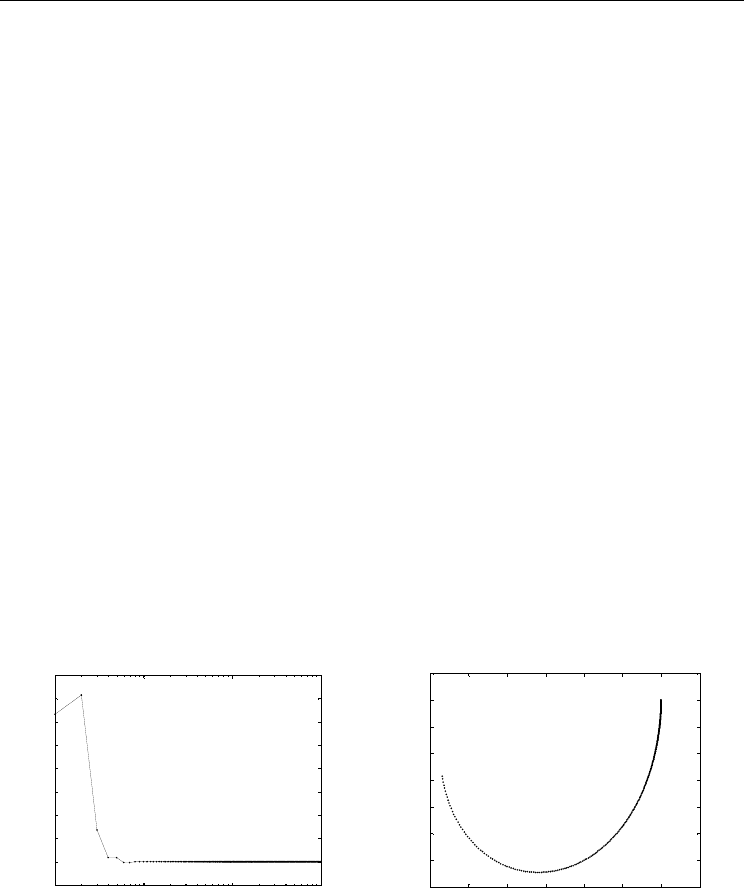
Particle Swarm Optimization
388
The influence of several factors can be analyzed in order to study the dynamics of the PSO
system, particularly the inertia factor I or the ϕ
i
factors, i = {1, 2}. This effect can vary
according to the population size, fitness function and iteration number used. As mentioned
previously, one particle of the initial population is changed randomly. The inertia parameter
influence is studied to analyze the effect of the perturbation for the values of
I = {0.50, 0.55,..., 0.80} versus the swarm population size pop = {6, 8,..., 12}. The variation of
the best global particle fitness evolution is taken as the system output signal as illustrated in
Fig. 2.
4.2 The PSO dynamics
Initially, the PSO system is executed without any initial perturbation signal, during
T
m
= 10000 iterations, for a predefined inertia weight value I and swarm population size.
The data regarding this test is stored, namely the global particle fitness and the stochastic
parameters. This experiment will serve as a reference test. The optimization system
perturbation consists in replacing the first initial particle of the stored reference swarm
population, in every algorithm execution, by another particle randomly generated. Indeed,
this stimulus to the system, results in a swarm fitness modification δf which is evaluated.
This perturbation test is repeated for n = 10000 cases. It is important to state that the
remaining test conditions, namely the stochastic reference stored values, remain unchanged
along the n experiments. Therefore, the variation of the resulting PSO swarm fitness
perturbation, during the evolution, can be viewed as the output signal which varies during
the successive iterations.
The output signal consists in the difference between the population fitness with and without
the initial perturbation, that is, δf(T) = f
pert
(T) − f(T). Figure 3a) shows the output signal
δ f(T), for one particle replacement, in the iteration domain. In each experiment the Fourier
transform of the signal perturbation, F[δ f(T)] (see Fig. 3b)) is evaluated in order to analyze
the dynamics.
10
0
10
1
10
2
10
3
-5
0
5
10
15
20
25
30
35
40
T
δ
f
-0.2 0 0.2 0.4 0.6 0.8 1 1.2
-0.7
-0.6
-0.5
-0.4
-0.3
-0.2
-0.1
0
0.1
ℜ
{H(jw)}
ℑ
{H(jw)}
a) Iteration domain b) Polar diagram
Figure 3. Output signal for an initial perturbation. Experiment with I = 0.7 and a swarm
population size of pop = 12 elements.
With the output signal Fourier description it is possible to evaluate the corresponding
normalized transfer function (4):
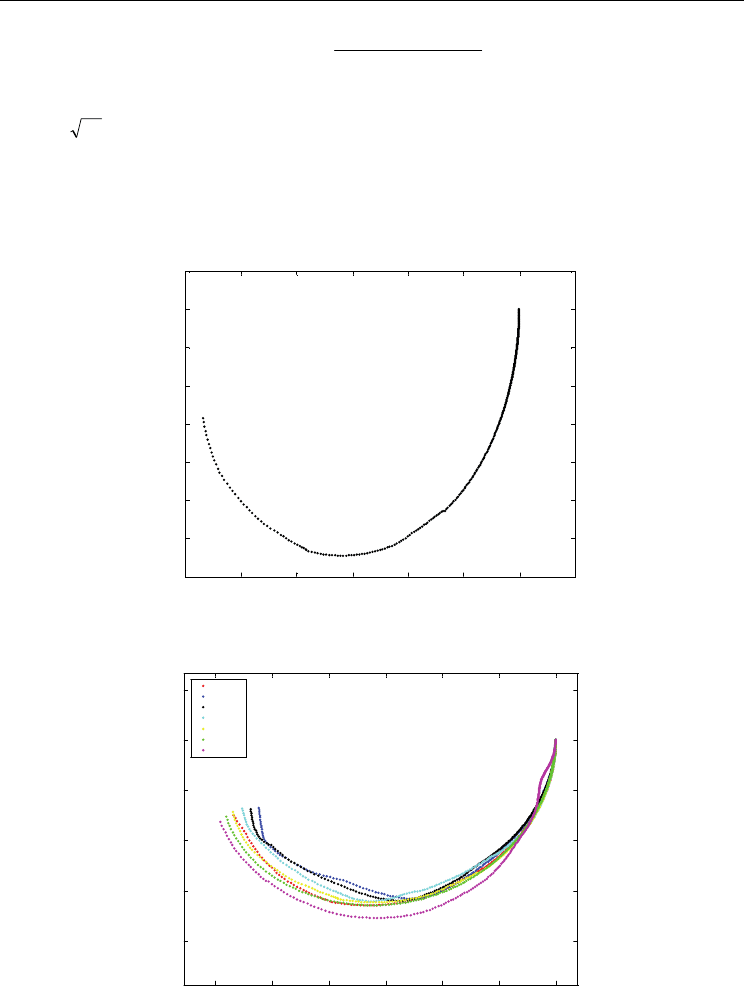
Particle Swarm Optimization: Dynamical Analysis through Fractional Calculus
389
)0)}(f({
))}(jf({
)H(j
=
=
ωδ
ω
δ
ω
TF
TF
(4)
where w represents the frequency, T the discrete time evolution (number of iterations used)
and
1j −=
. The transfer function H(jw) for this experiment is depicted in Figure 3b).
Finally it is obtained a ‘representative’ transfer function, by using the median of the
statistical sample (Tenreiro Machado & Galhano, 1998) of n experiments (see Figure 4).
Figure 5 shows the archieved results for inertial values of I = {0.50, 0.55,..., 0.80}. The medians
of the transfer functions calculated previously (i.e., for the real and the imaginary parts for each
frequency) are taken as the final result of the numerical transfer function H(jw).
-0.2 0 0.2 0.4 0.6 0.8 1 1.2
-0.7
-0.6
-0.5
-0.4
-0.3
-0.2
-0.1
0
0.1
ℜ
{H(jw)}
ℑ
{H(jw)}
Figure 4. Median transfer function H(jw) of n = 10000 experiments for an inertial term I = 0.7
and pop = 12 elements.
-0.2 0 0.2 0.4 0.6 0.8 1
-0.8
-0.6
-0.4
-0.2
0
0.2
ℜ
{H(jw)}
ℑ
{H(jw)}
I=0.50
I=0.55
I=0.60
I=0.65
I=0.70
I=0.75
I=0.80
Figure 5. Median transfer function H(jw), of the n experiments for I = {0.50, 0.55,…, 0.80} for
a population swarm of pop = 12 elements.

Particle Swarm Optimization
390
Varying the swarm population number of elements in the interval pop ∈ [6, 12] results in a
family of transfer functions. For a swarm size greater than 12 elements there is no difference
between the reference test and the perturbation tests. It can be concluded that with large
swarms an element has a negligible impact upon the search and, consequently, the
performance of the algorithm is independent of the initial swarm. On the other hand, in
small swarms, an element has a large impact on the evolution; therefore, it is necessary a
large number of perturbation tests to lead to a convergence towards the statistical sample
median. From the tests it can be observed that for I = 0.8 the median is very irregular
because the system is close to the instability region (den Bergh and Engelbrecht, 2006).
4.3 Dynamical analysis
In this section the median of the numerical transfer functions is approximated by analytical
expressions with gain k = 1 and one pole a ∈ R
+
of fractional order α ∈ R
+
, given by equation
(5):
α
ω
ω
⎟
⎠
⎞
⎜
⎝
⎛
+
=
1
j
)G(j
a
k
(5)
Since the normalized Fourier transform (H) is used, it yields k = 1. In order to estimate the
transfer function parameters {a, α} another PSO algorithm is used, which is named the
identification PSO. The identification PSO is executed during T
ide
= 200 iterations with a 100
particle swarm size. The PSO parameters are: {ϕ
1
, ϕ
2
}~U[0, 1.5], I = 0.6, and the transfer
function parameters intervals are a ∈ [4 × 10
-3
, 50] and α ∈ [0, 100].
To guide the PSO search, the fitness function f
ide
is used to measure the distance between the
numerical median H(jw
k
) and the analytical expression G(jw
k
):
∑
=
−=
nf
k
kk
1
ide
)G(j)H(j)(jf
ωωω
(6)
where nf is the total number of sampling points and w
k
, k = {1,...,nf}, is the corresponding
vector of frequencies.
As explained previously, the optimization PSO has stochastic dynamics. Therefore, every
time the PSO system is executed with a different initial particle replacement, it leads to a
slightly different transfer function. Consequently, in order to obtain numerical convergence
(Tenreiro Machado & Galhano, 1998) n = 10000 perturbation experiments are performed
with different replacement particles, while all the other particles remain unchanged. The
optimization PSO dynamics transfer function is evaluated by computing the normalized
signals Fourier transform (FT) (equation 4). The transfer functions medians determined
previously (i.e., for the real and the imaginary parts, and for each frequency) are taken as the
final result of the numerical transfer function H(jw).
Figure 6 and 7 show, superimposed, the normalized median transfer function H(jw) and the
corresponding identified transfer function G(jw), both as polar and amplitude diagrams,
respectively. As it can be observed from these figures the fractional order transfer function,
